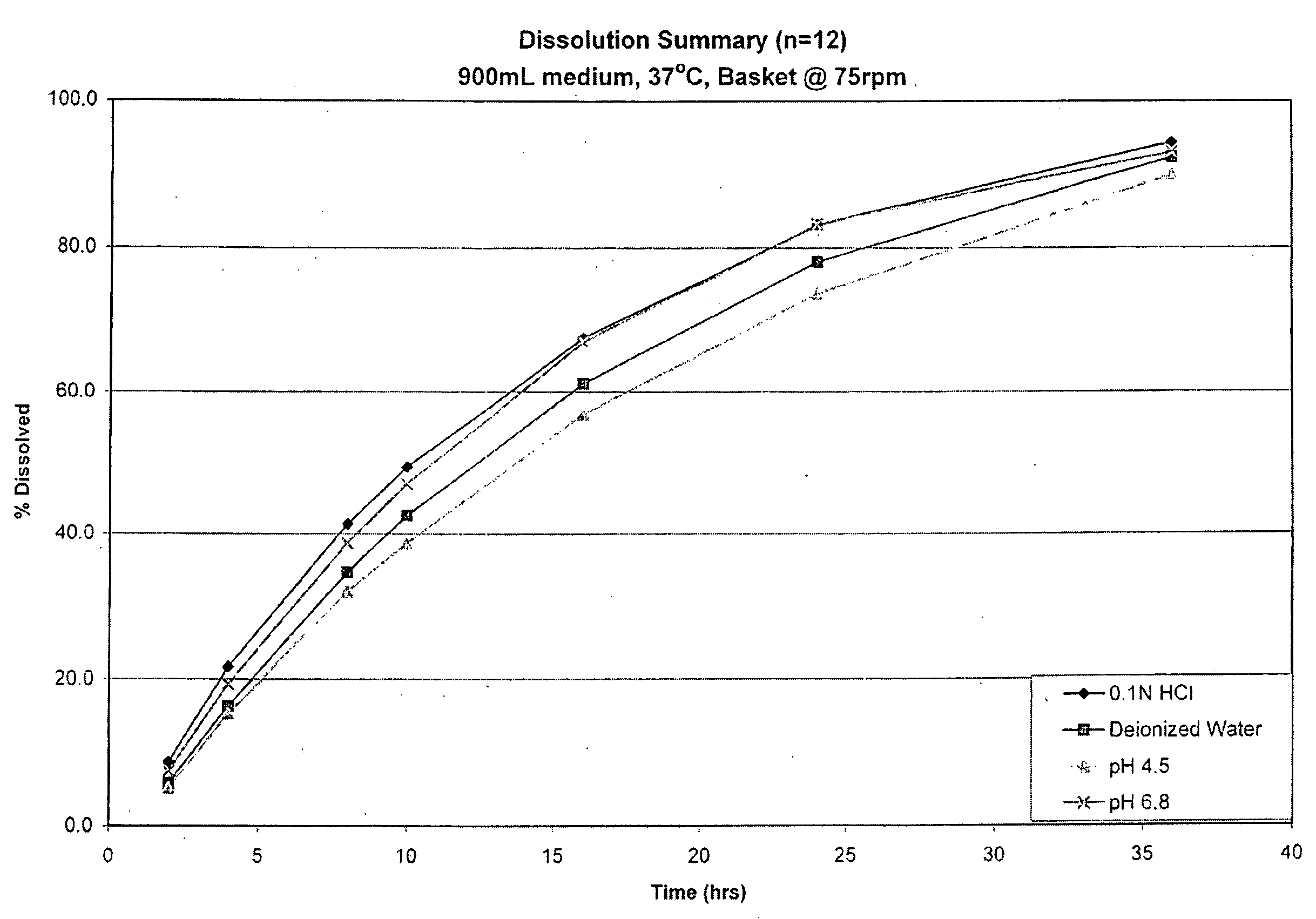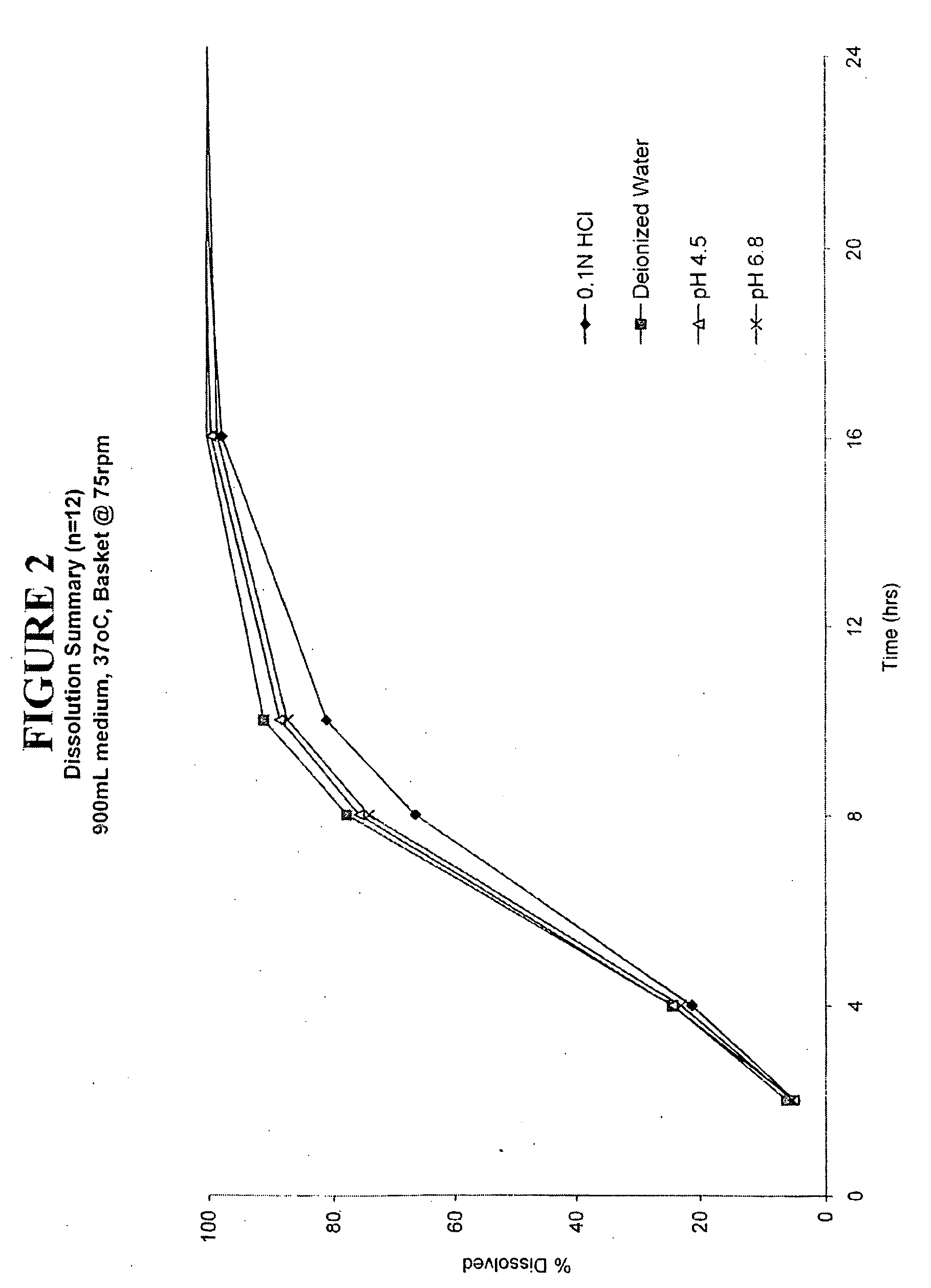Enteric coated hydrophobic matrix formulation
a hydrophobic matrix and enteric coating technology, applied in the direction of peptide/protein ingredients, biocide, heterocyclic compound active ingredients, etc., can solve the problems of undesirable retention in the stomach, complex multi-particulate system, and many processing steps, so as to increase the amount of enteric coating, reduce the amount of coating, and accelerate the effect of tmax
- Summary
- Abstract
- Description
- Claims
- Application Information
AI Technical Summary
Benefits of technology
Problems solved by technology
Method used
Image
Examples
example 1
[0079]A 100 mg enteric coated tramadol HCl tablet in accordance with the present invention was prepared as follows:
Matrix Tablet or Core
[0080]Approximately 9.6 kg of carnauba wax is heated to approximately 85° C. using a water-jacked melter. Once the carnauba wax is melted, 12.0 kg of Tramadol HCl, 12.0 kg of polyethylene glycol 3350 and 0.4 kg of stearic acid are added to the melt and mixed for approximately 15 minutes. The mixture is cooled and milled with a Fitzmill equipped with a 0.065″ screen to create approximately 34.0 kg of tramadol granules. Approximately 5 kg of the tramadol granules are blended with 0.7 kg of silicon dioxide for approximately 1 minute then milled with a Fitzmill equipped with a 0.065″ screen. The tramadol granules that have been mixed with the silicon dioxide and milled are blended with the remaining 29 kg of tramadol granules in a 5 cubic foot slant cone blender for approximately 13 minutes. The blended material is compressed into 0.3150″ round tablets ...
example 2
[0086]A 100 mg enteric coated tablet in accordance with the present invention was prepared according to the procedure described in Example 1. The final 100 mg tablet had the following composition:
Ingredient% (w / w)mg / tabletTramadol HCl32.67100.0Carnauba Wax, NF27.7785.0Polyethylene Glycol, NF31.0395.0Stearic Acid, NF1.093.33Silicon Dioxide, NF1.895.78EUDRAGIT ® S1001.655.06Triethyl Citrate0.170.51Talc, USP0.832.53OPADRY II, White2.918.92
[0087]The enteric coated tablets of Example 1, Example 2 and ULTRAM® ER, a commercially available extended release tramadol tablet, were tested in vivo according to standard FDA bioequivalency testing procedures. A general description of the in vivo testing procedures can be found in the FDA documents entitled “Guidance for Industry-Bioavailability and Bioequivalence Studies for Orally Administered Drug Products-General Considerations” March 2003 and / or “Guidance for Industry-Food-Effect Bioavailability and Fed Bioequivalence Studies” December 2002, w...
example 3
[0091]A 200 mg enteric coated tablet in accordance with the present invention was prepared according to the procedure described in Example 1. The final 200 mg tablet had the following composition:
Ingredient%(w / w)mg / tabletTramadol HCl30.63200.0Carnauba Wax, NF45.95300.0Polyethylene Glycol, NF15.32100.0Stearic Acid, NF1.026.67Silicon Dioxide, NF1.9012.38EUDRAGIT ® S1001.429.29Triethyl Citrate0.140.93Talc, USP0.714.64OPADRY II, White2.9119.02
[0092]The enteric coated tablet prepared in Example 3 was tested using a USP Type 2 apparatus (paddle) at 100 rpms, 37° C. in 900 ml of 0.1 N HCl. The results of this testing are as follows:
Time (hours)0.1 N HCl28%417%834%1041%1657%2472%3080%
PUM
| Property | Measurement | Unit |
|---|---|---|
| melting point | aaaaa | aaaaa |
| melting point | aaaaa | aaaaa |
| melting point | aaaaa | aaaaa |
Abstract
Description
Claims
Application Information
 Login to View More
Login to View More - R&D
- Intellectual Property
- Life Sciences
- Materials
- Tech Scout
- Unparalleled Data Quality
- Higher Quality Content
- 60% Fewer Hallucinations
Browse by: Latest US Patents, China's latest patents, Technical Efficacy Thesaurus, Application Domain, Technology Topic, Popular Technical Reports.
© 2025 PatSnap. All rights reserved.Legal|Privacy policy|Modern Slavery Act Transparency Statement|Sitemap|About US| Contact US: help@patsnap.com



